As we step into 2025, the world of landscaping is undergoing a significant transformation. The integration of smart technology and sustainable practices is redefining how we design, manage, and enjoy outdoor spaces. These trends resonate particularly well in British Columbia, where environmental consciousness runs deep. This blog explores the top landscaping trends in 2025, focusing on how smart technology and sustainable practices are shaping the future of outdoor spaces, with specific examples from IslandEarth Landscape, a leader in innovative landscaping solutions.
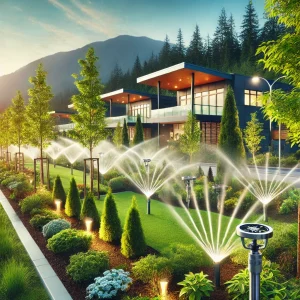
Smart Irrigation Systems: Precision in Water Management
Water conservation has always been a priority in landscaping, but in 2025, smart irrigation systems elevate it to a new level. These systems use advanced sensors and weather data to optimize watering schedules, ensuring that plants receive the right amount of water at the right time. In British Columbia, where water conservation is critical, IslandEarth Landscape implements smart irrigation solutions in several commercial properties. These systems reduce water usage by up to 30% and minimize maintenance costs, clearly demonstrating the benefits of integrating technology with sustainable practices.
Challenges: Although smart irrigation systems prove highly effective, they require a significant upfront investment. Additionally, these systems rely on precise data, which must be regularly maintained and updated to ensure accuracy.
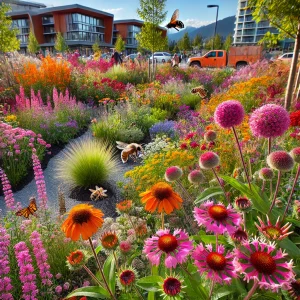
Sustainable Planting: Native Species and Pollinator Gardens
The trend towards using native plants and creating pollinator gardens is gaining momentum in 2025. Native plants adapt well to local climate and soil conditions, requiring less water and fewer resources to thrive. Pollinator gardens attract bees, butterflies, and other pollinators and play a vital role in supporting biodiversity.
IslandEarth Landscape leads this movement by designing landscapes that incorporate a variety of native species and pollinator-friendly plants. For instance, their recent project at a large commercial site in Victoria included a pollinator garden that attracts a diverse array of wildlife, enhancing the ecological value of the space.
Challenges: While native plants are easier to maintain, they may not always align with a client’s aesthetic preferences. Additionally, creating a balanced ecosystem requires careful planning and ongoing maintenance to prevent invasive species from disrupting the garden.
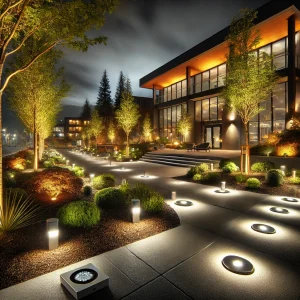
Energy-Efficient Lighting: Illuminating with a Conscience
With the rise of smart lighting systems, outdoor spaces can now be illuminated efficiently and sustainably. These systems use LED technology, motion sensors, and timers to reduce energy consumption. In British Columbia, where energy efficiency is a key concern, IslandEarth Landscape incorporates smart lighting solutions into its designs, particularly in urban commercial settings.
A notable example is their work on a mixed-use development in Vancouver, where smart lighting enhances the space’s aesthetic appeal and significantly reduces energy costs. These systems adjust brightness based on the time of day and activity levels, providing optimal lighting while minimizing energy use.
Challenges: Although energy-efficient lighting systems offer long-term savings, the initial installation cost can be a barrier for some clients. Additionally, these systems require a stable power source and regular maintenance to function correctly.
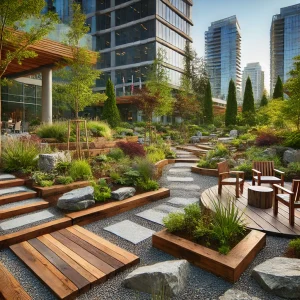
Eco-Friendly Hardscaping: Sustainable Materials in Action
Hardscaping—the use of non-plant elements like stone, wood, and metal in landscape design—has taken a sustainable turn in 2025. There is a growing preference for using recycled, reclaimed, or locally sourced materials. This trend not only benefits the environment but also adds a unique character to outdoor spaces.
IslandEarth Landscape embraces this approach, incorporating eco-friendly hardscaping materials into their projects. For instance, a luxury resort on Vancouver Island utilized reclaimed wood and locally sourced stone to create pathways and seating areas that blend seamlessly with the natural surroundings.
Challenges: Sustainable hardscaping materials can be more expensive and harder to source than conventional options. Additionally, clients may need education on the long-term environmental and aesthetic benefits of these materials.
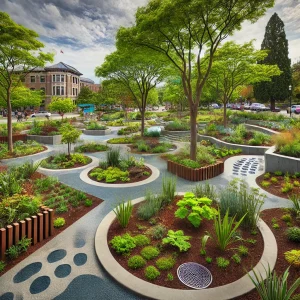
Climate-Adaptive Landscaping: Preparing for the Future
As climate change continues to impact weather patterns, the need for climate-adaptive landscaping has become more apparent. This trend involves designing landscapes that withstand extreme weather conditions like drought, heavy rainfall, and temperature fluctuations. In British Columbia, where climate variability is a growing concern, IslandEarth Landscape proactively implements climate-adaptive strategies.
One such project involved redesigning a public park in Victoria. Drought-resistant plants, permeable paving, and rain gardens manage stormwater runoff. These features not only protect the landscape from climate extremes but also enhance its resilience and longevity.
Challenges: Climate-adaptive landscaping requires careful planning and a deep understanding of local climate trends. It may also involve higher initial costs and ongoing monitoring and adjustments to ensure the landscape remains effective over time.
The landscaping trends in 2025 reflect a growing commitment to sustainability and technological innovation. In British Columbia, where environmental stewardship is a priority, these trends are not just about aesthetics—they aim to create resilient, efficient outdoor spaces that harmonize with nature. IslandEarth Landscape’s work exemplifies how smart technology and sustainable practices can come together to shape the future of landscaping, offering valuable insights and inspiration for both professional landscapers and homeowners alike. As we look to the future, these trends will continue to evolve, driving the landscaping industry toward a more sustainable and tech-savvy direction.